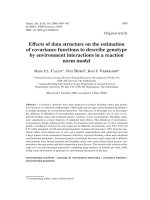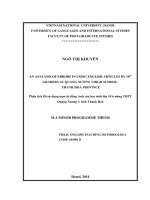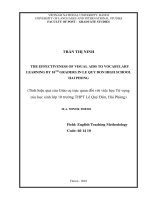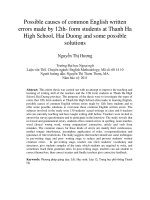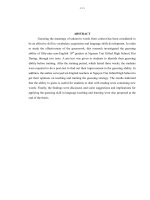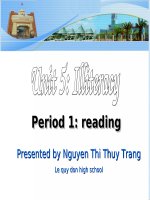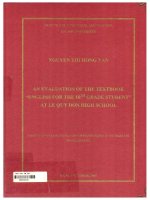The effectiveness of visual aids to vocabulary learning by 10th graders in Le Quy Don High School, Hai Phong = Tính hiệu quả của Giáo cụ trực quan đối với việc
Bạn đang xem bản rút gọn của tài liệu. Xem và tải ngay bản đầy đủ của tài liệu tại đây (638.69 KB, 48 trang )
VIETNAM NATIONAL UNIVERSITY, HANOI
UNIVERSITY OF LANGUAGES AND INTERNATIONAL STUDIES
FACULTY OF POST - GRADUATE STUDIES
TRẦN THỊ NINH
THE EFFECTIVENESS OF VISUAL AIDS TO VOCABULARY
LEARNING BY 10TH GRADERS IN LE QUY DON HIGH SCHOOL
HAI PHONG
(Tính hiệu quả của Giáo cụ trực quan đối với việc học Từ vựng
của học sinh lớp 10 trường THPT Lê Q Đơn, Hải Phịng)
m.a. minor thesis
Field: English Teaching Methodology
Code: 60 14 10
Hanoi - 2010
VIETNAM NATIONAL UNIVERSITY, HANOI
UNIVERSITY OF LANGUAGES AND INTERNATIONAL STUDIES
FACULTY OF POST - GRADUATE STUDIES
TRẦN THỊ NINH
THE EFFECTIVENESS OF VISUAL AIDS TO VOCABULARY
LEARNING BY 10TH GRADERS IN LE QUY DON HIGH SCHOOL,
HAI PHONG
(Tính hiệu quả của Giáo cụ trực quan đối với việc học Từ vựng của
học sinh lớp 10 trường THPT Lê Q Đơn, Hải Phịng)
m.a. minor thesis
Field: English Teaching Methodology
Code: 60 14 10
Supervisor: Nguyễn Bàng, M.A
Hanoi - 2010
iv
Table of contents
DECLARATION…………………………………………………………………………………………………………………………....
i
ACKNOWLEDGEMENTS…………………………………………………………………………………………………………
ii
ABSTRACT…………………………………………………………………………………………………………………………….………
iii
TABLE OF CONTENTS…………………………………………………………………………………………………….………
iv
Part a: Introduction……………………………………………………………………………………………………………..
1
1. Rationale………………………………………………………………………………………………………………………………….
1
2. Aims of the study…………………………………………………………………………………………………………….……
2
3. Significance of the study…………………………………………………………………………………………….………
2
4. Scope of the study…………………………………………………………………………………………………………….…..
2
5. Research questions…………………………………………………………………………………………………………….…
2
6. Design of the study……………………………………………………………………………………………………….………
3
Part b: development
4
Chapter I: Literature review…………………………………………………………………………………………….
4
1.1. Vocabulary and it roles in language learning
………………………………………………………....
4
1.2. What students need to know ?…………………………………………………………………………………..……
5
1.2.1. Form: pronunciation and spelling……………………………………………………………………...…
5
1.2.2 Meaning and use in communication……………………………………..………………………………
6
1.2.3. Grammar……………………………………………………………………..………………………………………………...
7
1.2.4. Collocation……………………………………………………………………..……………..……………………………… 7
1.3. Visual aids in teaching and learning vocabulary……………………………………………………… 7
1.3.1. Definitions of visual aids……………………………………………………………………………………..….
8
1.3.2. Classification of visual aids in term of the different media of visual aids 8
1.3.3. Classification of visual aids in term of significant difference of function 14
in the teaching process…………………………………………………………………………………………….
14
1.3.4. The effectiveness of visual aids in teaching and learning vocabulary……………….…
15
Chapter II: Methodology……………………………………………………………………………………………………..
18
2.1. Research questions……………………………………………………………………………………………………………..
18
.
v
2.2. The participants…………………………………………………………………………………………………………………… 18
2.3. The methods of the study ………………………………………………………………………………………………..
18
2.3.1. The questionnaires………………………………………………………………………………………………..…….
18
2.3.2. Class observation……………………………………………………………………………………………………….
18
Chapter Iii: Data analysis and discussion…………………………………………………………………..
22
3.1. Situation analysis……………………………………………………………………………………………………………..…
22
3.1.1. The setting of the study……………………………………………………………………………………………
22
3.1.2. Learners and their background……………………………………………………………………………..
22
3.1.3. Materials and facilities…………………………………………………………………………………………….
23
3.2. Findings and discussions form survey questionnaires……………………………………………
24
3.2.1. Survey questionnaire for students………………………………………………………………………
24
3.2.2. Survey questionnaire for teachers………………………………………………………………………
29
3.3. Data from the class observation……………………………………………………………………………………… 32
Chapter IV: Pedagogical implications…………………………………………………………………………… 35
Part c: conclusion……………………………………………………………………..……………………………………..……...
38
1. Recapitultion……………………………………………………………………………………………………………………….…
38
2. Limitation of the study ………………………………………………………………………………………..………….…
39
3. Suggestions for further study ……………………………………………………………………………………………
39
References
40
APPENDICES………………………………………………………………………………….……………………………………..……
I
1
PART A: INTRODUCTION
1. Rationale
In a language, vocabulary plays a significant role. It helps people arrange ideas,
prepare speeches to communicate with others etc... That vocabulary is of great importance to
language is agreed by many researchers. Rivers (1981: 462) emphasized : "Language is not
dry bones. It is living growing entity, clothed in the flesh of words”. As a result, vocabulary
learning is a means of mastering a foreign language. In teaching and learning English, it is the
basis for learning other skills. Despite the importance of vocabulary in helping learners of
English improve their language competence, the question of how to teach and learn
vocabulary effectively is always raised by both teachers and students. As beginners, the 10 th
graders at Le Quy Don high school often find it challenging to learn vocabulary, and a lot of
questions about how to learn vocabulary in an effective way are raised. What students are
wondering is always haunted in the teachers’ mind most of the time, which inspires them to
find out suitable solution to vocabulary teaching and learning to satisfy their students’ needs.
One of the most effective way to teach vocabulary is through visual aids. Using visual aids to
help students learn vocabulary is not the newly - arisen one. However, their effectiveness to
students’ vocabulary learning worth considering by all teachers, because what students can see
and touch will be perceived in their mind better than what they can hear only. Learning
vocabulary through visual aids brings about good results. When a teacher uses visual aids, the
students’ attention is more completely focused since visual aids provide one mechanism to direct
and focus attention. In addition, visual aids make a teacher more persuasive in teaching
vocabulary then increase students’ understanding of the topic.
The adage “A picture is worth a thousand words” is totally true because visual aids can
help establish organization for presentation. In other words, one of the most effectiveness of
visual aids is establishing the overall organization for the presentation; therefore, students look
for order in everything they have experienced. However, up to now there have not been any
studies on the effectiveness of visual aids in learning vocabulary. All the above reasons are the
2
motivation and the driving force for this study in which the use of visual aids and their
effectiveness to 10th graders in Le Quy Don high school, Hai Phong will be investigated. It is
hoped that this study will help those wanting to improve their vocabulary teaching find
feasible ways to raise students’ interest in learning vocabulary.
2. Aims of the study.
The aims of the study are:
- The students’ attitude toward visual aids.
- To investigate the effectiveness of visual aids to vocabulary learning by 10th graders
in Le Quy don high school, Hai Phong.
3. Significance of the study
It is hoped that this study will be significant for both teachers and learners of English
in terms of vocabulary teaching and learning. In addition, it would become a good source
reference to those who concern vocabulary. Therefore, it is believed that this study will
contribute to the development of English teaching and learning throughout the country.
4. Scope of the study
Visual aids are really a large category which may be applied to teach all language
skills such as: listening, reading, speaking and writing as well as other language components:
vocabulary, grammar, pronunciation, etc. However, since both limited time and experience the
study could hardly cover all aspects. It, therefore, would focus on the effectiveness of visual
aids to vocabulary learning by 10th graders at Le Quy Don high school, Hai Phong.
5. Research questions
3
The study was carried out to investigate the effectiveness of visual aids to vocabulary
learning by 10th graders at Le Quy Don high school, Hai Phong, therefore, aimed at answering
the following questions:
1. Do you students like learning vocabulary through visual aids?
2. How effective are visual aids to students’ vocabulary learning ?
3. How much progress have students made in learning vocabulary with visual aids?
6. Design of the study
The study is divided into three parts.
Part A: Introduction
This part provides a general introduction of the study with the specific reference to the
rationale, the aims, the methods, the significance and the design of the study.
Part B: Development
The development of the study consists of four chapters, as follows:
Chapter one- “Literature Review”: Gives a brief view on motivation, the theoretical
background of English vocabulary, the overall view of some visual aids and the effectiveness
of visual aids in vocabulary lessons.
Chapter two - “Methodology”: Gives an insight into the research methods to find out
the answers to the research questions. Also, this chapter gives a brief view on the subjects and
the procedures of the study.
Chapter three - “Finding and discussion”: Presents the data collected from the survey
questionnaires, class observation and the discussion of these data
Chapter four - Pedagogical implications:
Suggests some solutions to vocabulary
teaching and learning
Part C: Conclusion
This part presents a conclusion and review of the study ending with limitation of the
study and suggestion for further research
PART B: DEVELOPMENT
4
CHAPTER I: LITERATURE REVIEW
1.1. Vocabulary and it roles in language learning.
Vocabulary in English is a large aspect. Therefore, it has been paid much attention to
by many linguists. However, there have been different definitions of vocabulary. Each linguist
gives his/her own definition of vocabulary depending on the criteria that s/he considers the
most important in terms of linguistics, semantics, lexicology, etc. Vocabulary is defined as
words used by a particular language book. Ur (1996) defined vocabulary roughly as “the
words we teach in the foreign language”. However, she also accepted, “a new item of
vocabulary may be more than a single word”. Pyle and Algeo (1970: 96) also stated, “When
most of us think about language we think first about words. It is true that the vocabulary is the
focus of language. It is words that sounds and meanings interlock to allow us to communicate
with one another, and it is word that we arrange together to make sentences, conversation and
discourse of all kinds”. These statements indicate that vocabulary is the total number of words
of a language and it is an essential part of language. Therefore, it cannot be denied that
vocabulary plays a significant role in language teaching and learning. Davies and Pearse
(2000: 59) stated, “In communication, vocabulary is often more important than grammar. It is
frustrating for intermediate learners when they discover they cannot communicate effectively
because they do not know many of words they need”. Supporting their points of view, Wilkins
(1972: 111)
emphasized that “Without grammar, very little can be conveyed. Without
vocabulary, nothing can be conveyed”. From researchers’ ideas, it shows a fact that non-native
speaker needs vocabulary first in order to communicate. If a language was a house vocabulary
would be as construction material to build up that house. Thus, it is needless to say vocabulary
is important or not
In teaching and learning English, learning vocabulary is worth learners’ great attention.
Vocabulary has not been a subject for students to learn lately but has been taught within
5
lessons of reading, writing, speaking and listening. It is true that vocabulary knowledge
contributes to reading success in other important ways that are perhaps less obvious. If a
learner has a wide range of vocabulary, he/she can understand others easily; on the contrary, if
his vocabulary is limited he /she will surely has difficulty in mastering English.
To sum up, knowing vocabulary of a language is a minimum self-requirement for those
who want to learn a foreign language.
1.2. What students need to know?
According to Ur (1996) there are many aspects concerning words, which need to be
taught. They are form, grammar, collocation, meaning and word formation. Davies and Pearse
(2000: 60) also emphasized that: “the aspects of new vocabulary items that you may need to
know about and learners may need to learn are similar to those of other new language items
such as grammatical patterns or functional expressions. Essentially, these aspects are meaning,
use in communication, pronunciation and spelling, and grammar.” As mentioned above,
learning a word means learning at least, its form, its meaning, and its use.
1.2.1. Form: Pronunciation and spelling
Ur (1996) stated, “The learner has to know what a word sounds like (its pronunciation)
and what it looks like (its spelling). These are fairly obvious characteristics, and one or the
other will be perceived by learners when encountering the item for the first time. In teaching,
we need to make sure that both these aspects are accurately presented and learned”. It means
that in learning vocabulary, “students must learn how item is pronounced, and how it is
written” (Davies and Pearse, 2000: 63). Therefore, this can be particularly problematic for
learners of English because there is often no clear relation between pronunciation and spelling
1.2.2. Meaning and use in communication
6
Another important aspect of vocabulary teaching and learning is the meaning. Ur
(1996) indicated that the meaning of a word is primarily what it refers to in the real world, its
denotation; this is often the sort of definition that is given in a dictionary. For example, ‘dog’
denotes a kind of animal; more specifically, a common domestic carnivorous mammal; and
both “dank” and ‘moist” mean slightly wet. A less obvious component of the meaning of an
item is its connotation: the associations, or positive or negative feelings it evokes. This
meaning may or may not be indicated in a dictionary. For instance, the word dog, as
understood by most British people, has positive connotations of friendship and loyalty;
whereas the equivalent in Arabic, as understood by most of the Arab countries has negative
associations of dirty and inferiority. The connotative meaning of a word is varied from context
to another.
A more subtle aspect of meaning that often needs to be taught is whether a particular
item is the appropriate one to use in a certain context or not. Thus, it is essential for learners to
know that a certain word is very common, or relatively rare. This means that words can
suggest different things depending on context they occur in. A learner who fails to understand
the connotation of a word will probably fail to get the message of the text. It is clear that how
the meaning of one item relates to the meaning of others is important in teaching. Therefore, it
is paid much attention and taught in vocabulary acquisition. Such various relationships are
listed as synonyms (to distinguish between the different shades of meaning that synonymous
words have), antonym (items that means the opposite), hyponyms (to distinguish between the
various meaning of a single word for which has several meanings which are not closely
related), co - hyponyms or co – ordinates (refer to other items that are the “same kind of
thing”), super- ordinates (show general concepts that “cover” specific items), and translation.
In short, the words have various types of meaning. It is required that the teacher has to make a
careful choice of and decision on which meaning of a word to teach and how many meanings
and words to teach in the given class time.
1.2.3. Grammar
7
Ur (1996) indicated that the grammar of a new lexical item will need to be taught if
this is not obviously covered by general grammatical rules. An item may have an unpredicted
change of form in certain grammatical contexts or may have some idiosyncratic way of
connecting with other words in sentences; it is important to provide learners with this
formation at the same time as the base form is taught. When teaching a new verb, we might
also give its past form if this is irregular (give, gave). This can be helpful to students because
they can avoid making mistakes in using word form.
1.2.4. Collocation
According to Ur (1996), the collocation typical of particular items are another factor
that makes a particular combination sound “right” or “wrong” in a given context. Therefore,
this is another piece of information about new item, which it may be worth teaching. When
introducing words like “decision” and “conclusion”, for example, teachers may note that you
“take” or “make” the one, but usually “come” to the other. Collocations are also often noted
in dictionaries, either by providing the whole collocation under one of the head - words, or by
a note in parenthesis.
In conclusion, students should be taught the form, the meaning, the grammar, and
collocation of words in vocabulary lesson.
1.3. Visual aids in teaching and learning vocabulary
Vocabulary possesses a variety of aspects that need paying attention to and learning.
Thus there are a numerous techniques concerned with vocabulary teaching. Up to now, using
visual aids has been one of the most effective techniques in teaching vocabulary.
1.3.1. Definitions of visual aids
8
The term “visual aids” suggests in the first instance things brought into classroom, like
charts, slides, and film, some extra, possibly non – essential, which helps the teacher to do
his/her job better. The teacher, therefore, cannot do his/her job at all without visual help. In the
language teaching situation, admittedly, various definitions of visual aids have been proposed
over the course of decades of research. Widdowson (1975: 211) defined visual aids as
“anything which can be seen while the language is being spoken”. Similarly, Sesnan (2001:
208) pointed out that: “visual aid is the name we give to something extra which you use to
make your teaching more effective. The word “visual” is connected with other words for
‘sight”.
In conclusion, visual aids include graphs, tables, models, diagrams, photographs, and
pictures etc..., which help to encourage students’ interest in learning new lexical items. Thus,
it is expected that teachers employ visual aids in their vocabulary teaching.
When various traditional “visual aids” are discussed, they tend to be divided into such
group as wall charts, book illustration, ‘relia’ model, puppets, maps, film strip, moving film,
television. Widdowson (1975: 212) stated that: “these classifications are natural and often
helpful, but they relate to the different media of visual aids, not to the significant difference of
function in the teaching process.” He suggested another way of classifying visual aids, which
may help us to understand their function better, and hence help us to use them better and more
imaginatively in the classroom. He classified visual aids in term of the different media of
visual aids and in term of the significant difference of function in the teaching process.
1.3.2. Classification of visual aids in term of the different media of visual aids
1.3.2.1. Boards
The simplest classroom visual aid of all classrooms is the board, black or white. It has
great possibilities for pictorial representation, yet most teachers seldom use it except for
writing lists of words or paradigms on it.
9
According to Davies and Pearse (2000:154) the board is usually the most basic piece of
classroom equipment. They stated that: “a lot can be done with it if you know: for instance,
writing up examples and exercises, or supporting your teaching with diagrams, tables, and
drawings” Gower (1995:159) also supported their idea: “it is unusual to find classroom
without a board of some kind, whether it is white, black or green.”. It is clear that the boards
are divided into two types: chalkboards and white boards. The chalkboards are found in most
classrooms. They are usually black or green. Wright & Haleem (1991: 5) indicated that they
are “cheap to install, easy, and cheap to use and very adaptable” . Thus, chalkboard is said to
be the most common and useful visual aids for teachers. The teachers can make use of
chalkboards. It is clear that they are available, inexpensive and teachers can use them
whenever they like to teach a lesson. That they do not depend on other factors like electricity
supply is very important thing to use them in teaching
The teachers, therefore, can use chalkboards for to serve their different purposes. It is
useful in presenting vocabulary, spelling, giving a model, etc. However, how effective are they
depends on the way they are used. Many teachers usually think that boards are the places
where they present the outline of the lesson plans and write examples on only. In fact, they can
make use of the board to exploit it to its fullest potential by drawing on the board to present
new words. Also, by that way they can create visuals and make their lessons much more
interesting.
Doff (1988) suggested using such chalkboard drawings as stick figures to teach
vocabulary. He gave some tips to teach vocabulary by using chalkboard drawing. Doff (1988)
suggested that: “Heads should be large enough to be seen from the back of the class.
Expression can be indicated by changing the shape of the mouth”.
10
“The direction of speaker is facing can be indicated by changing the note ( This is useful if
you want to show two people having a conversation)” (p.17)
“Sex and age can be indicated by drawing hair” ( p. 17)
In conclusion, the most versatile piece of teaching equipment is the board. Boards
provide a motivating focal point during whole - class grouping
1.3.2.2. Pictures
Pictures are kind of visual aids which might be m o r e effectively to develop and
sustain motivation in producing positive attitudes towards English teaching and learning. It is
said that a picture can save a thousand words. Although it has been mentioned that a picture of
something is less useful than the thing itself, for such things the teachers cannot bring to
classes as: trees, cars, mountains, etc. they can use a picture instead of the thing itself. ,
pictures can not only bring images of reality into the unnatural world of the language
11
classroom, but also function as a fun element in the class. Pictures meet with a wide range of
use not only in acquiring vocabulary, but also in many other aspects of foreign language
teaching. Wright (1990: 4-6) demonstrated this fact on an example, where he used one
compiled picture and illustrated the possibility of use in five very different language
areas. His example shows employing pictures in teaching structure, vocabulary, functions,
situations and all four skills. Moreover, he pointed out that “potential of pictures is so
great that only a taste of their full potential can be given” in his book. According to Bowen
(1982) pictures can be divided into wall pictures and wall charts; flashcards, work cards and
sequence picture.
1.3.2.2.1. Wall pictures and wall charts
Bowen (1982:13) defined “A wall chart is a large diagram or picture display card.
Most wall charts consist of combinations of visual and verbal material. Their aim is to give
information on a topic. A wall picture, on the other hand, is simply a large illustration of a
scene or event, or a set of scenes or events . Davies and Pearse (2000: 157-158) stated that:
“Wall - charts can be scenes like the national park”
,
or
“separate
but
related
pictures”
Generally, wall pictures can be seen by the whole class. So they are used with the
whole class. Besides, “wall – charts need to be clear for all learners, including those at the
back of the room or out side. This meant that you need to select cut – out pictures which are
12
large enough, and with strong outlines or contrasting tones, not all dark or light tones. Any
writing on the wall - chart also needs to be large enough and in strong colour or dark tone.”
(Davies and Pearse, 2000:158)
1.3.2.2.2. Flash cards
Flash cards are pieces of paper in which words, sentences arc written or pictures are
drawn. They can be divided into two main kinds; picture flashcards, word flashcards.
1.3.2.2.2.1. Word flash cards
According to Bowen (1982), word flash cards are cards on which words have been
printed and they can be held up rapidly or “flashed” by the teacher before the class. Wright &
Haleem(1991: 59) also indicated that “ word flash cards are usually about 8cm in height and
are as long as is necessary for the text” . They pointed out the following characteristics of
word flash cards: “Word flash cards are easy and inexpensive for the teacher to prepare. The
cards are easy to store and to carry into classroom. They are easy for the teachers and students
to handle and to use at the appropriate moment. They can be held, propped, or stuck to the
board. A number of cards can be displayed at the same time: by asking several students to hold
them, by sticking them to the board, by clipping them to a wire, by propping them to a shelf,
by using a sentence maker” . Generally, word flash cards are inexpensive, easy to make, store
and carry to classes, and they can be held, propped, or stuck to any objects in the classroom.
Nevertheless, they will find their use in teaching vocabulary too, offering valuable
help mainly in teaching the spelling of newly learnt words, which definitely should not be
neglected as it often is.
1.3.2.2.2.2. Picture flash cards
Wright & Haleem (1991) stated that “picture flash cards are pictures mounted on cards
approximately 15 cm by 20 cm” .They also point out the following characteristics of picture
flash cards. Like word flash cards “picture flash cards are inexpensive, easy for teachers to use
13
in the conduct of the lesson. The cards must be small enough to handle easily but large enough
for every student to see. One or more cards can be displayed at any one time by teachers or
students. ”.As for classroom use, picture flash cards “are more suitable for the representation
of a single concept, such as an object or an action. It is best to use picture flash cards for the
revision and practice of previously taught language, rather than for the presentation of new
items.” (Bowen, 1982:28)
1.3.2.2.3. Work cards
Ur clarified that “work cards are made in sets, each card offering a different, fairly
short task. They are not written on: a student does one card, writing answers on a separate
piece of paper or in a notebook, and then exchanges it for another working through as many of
the set as there is time for.” . Bowen (1982: 31) made it more clearly when stating “work cards
can include visual as well as text. Magazine pictures, drawings, maps and diagrams can be
important parts of work cards at all levels, used for a variety of purposes” .Finally, work cards
contribute to create interests and therefore motivate students in learning vocabulary.
1.3.2.2.4. Sequence pictures
Sequence pictures are a series of pictures on a single object. They reveal their story or
theme like a strip cartoon in a connected set of illustrations. Each picture will help students to
find out the meanings of the others that lead them to gain an overall scene of the story of
theme. That is the way of teaching reading linking together in a process. To sum up, “for
helping students understand the meaning of a word, we often find that a picture is useful” (
Allen, 1983: 24). It is clear that there are various types of pictures to be used for language
learning, practicing and organizing. They differ regarding their size, form and origin, which
makes them fit for a number of activities depending on their type. For several reasons,
they help students remember the words better and they help the teacher to make the lesson
more interesting and beneficial.
14
1.3.2.3 Real objects
Real objects or realia are anything available without special preparation or materials
that students can see in class from the simplest things such as tables, chairs, pens, books, etc to
more concrete things such as modem machines, natural phenomena (hot, cold, rain, etc.) and
so on. Sesnan (2001) said that: “Perhaps the most useful aids are real objects which you use
as part of role play or as part of vocabulary development”. In conclusion, real objects or
models of real objects are very effective and meaningful in showing meanings but in handling
of real objects, a teacher must be practical and should not be superfluous because in fact
sometimes teachers cannot find out the real things to explain new words.
1.3.2.4. Mine and gesture
Mine and gesture said to be the cheapest visual aids. These kinds of visual aids cost
you nothing but some energy to mime, make gestures or express your face. However, they can
bring about considerable effects when teaching vocabulary. “These are often used to
supplement other ways of conveying meaning. When teaching an item such as ‘to swerve’, a
teacher might build a situation to illustrate it, making use of the blackboard or gesture to
reinforce the concept” (Gairns and Redman, 1986:73)
1.3.3. Classification of visual aids in term of significant difference of function in the
teaching process: Visual materials for talking about and Visual materials for talking
with.
Widdowson (1975) pointed out that: “there is no hard or fast line between these two
types. The division is made principally in order to draw attention to the relation between ‘
thing’ and ‘ language’ in the world out side classroom, which is meant to reflect” .He made it
clear by giving some examples: a pair of scissors can be used for talking about and for talking
with. The teacher may bring them into the classroom; he may talk about them, their shape,
their material, their use. He can ask the students about them and get them to describe them.
15
These are well - tried and familiar techniques and correspond to the use generally made of
conventional visual aids. But such language behavior is normal only in the classroom.
Nobody, except perhaps cutlers, describes and talks about scissors, in the world outside.
In fact, although describing and talking about physical objects and pictures is a
perfectly proper used of language, it is not very common in everyday social intercourse, it
occurs more often in specialized academic, technical, artistic situations, and in what we might
call ‘ demonstration situation’. This is what Widdowson (1975) called talking about things or
“using visual material for talking about”. Widdowson (1975) also stated that: “Plenty of
examples of ‘thing’ come to mind, which can be used both for talking about and talking with:
tools, instruments, money, clothes, toys, and, of course, the familiar model shop.”He showed
that “better the real thing to talk with than a picture of it to talk about.”
In conclusion, visual aids are available in many forms which are often used lot in
teaching vocabulary. And, it is hoped that the use of visual aids will help students much in
learning vocabulary.
1.3.4. The effectiveness of visual aids in teaching and learning vocabulary
The effectiveness of visual aids in teaching a foreign language has been appreciated by
many linguists. Vocabulary is an aspect of a language. Thus, using visual aids in teaching
vocabulary will certainly bring both the teachers and students a lot of benefit as well.
First of all, visual aids are beneficial as it is proved that what students see will be percepted in
the mind better than what they hear. It is indicated what students see has a great influence on
their learning process. It is clear that the more senses that are used, the learning takes place.
The following famous Chinese saying points this out:
“If I hear it, I forget it. If I see it, I remember it .If I know it, I know it”
Moreover, students usually feel more comfortable and less stressed when they are
taught vocabulary through visuals. Many students think that learning vocabulary is very
boring. They find it hard to remember all the words taught by the teacher, especially when the
16
teachers only explain the words verbally. The same situation will not happen when the
teachers use visual aids to teach vocabulary. Visuals will help to make the atmosphere in the
classroom more enjoyable and then learning vocabulary will become more interesting and
fascinating in the eyes of the students. They not only hear the teacher, but also involve in the
lesson. They become much more active. They are, therefore, motivated to learn vocabulary.
Furthermore, Doff (1988) indicated that “Having something to look at keeps the
students’ attention, and makes the class more interesting” . It means that visual aids help
emphasize a point, which is another benefit to using them. They can help break information
down to manageable pieces for students to focus attention on meaning and make the language
used in class more real and alive.
In conclusion, visual aids can help the teachers save time, energy and add interest.
More important, they improve students understanding of vocabulary and they allow for
different learning styles. It can be said that using visual aids is a good solution for those who
want to motivate their students in learning vocabulary. Thus teachers cannot ignore the visual
aids in teaching, but join it, involve in it and make use of it for the sake of our English
teaching.
In this chapter, some theoretical background knowledge and views on vocabulary, the
role of vocabulary, what need to be taught when teaching vocabulary and visual aids as well as
the benefits of using visual aids to motivate students to learn vocabulary have been introduced
to the extent that best suits the scale of the research. However, at my school there have not
been any studies done on this subject. That is the reason why I decided to carry out an
investigation into the effectiveness of visual aids in learning vocabulary by 10th graders. It is
hoped that through this study some kinds of changes will be made to help students learn
vocabulary better. The presentation and discussion of the data collected from the
questionnaires and class observation served to answer the research questions will be given in
the next chapters.
17
CHAPTER II: METHODOLOGY
This chapter presents the research methodology to achieve of the aims and objectives
of the study
2.1. Research questions
18
The study was carried out to investigate the effectiveness of visual aids to vocabulary
learning by 10th graders at Le Quy Don high school, HaiPhong; therefore, aimed at answering
the following questions:
1. Do you students like learning vocabulary through visual aids?
2. How effective are visual aids to students’ vocabulary learning?
3. How much progress have students made in learning vocabulary with visual aids?
2.2. The participants
The participants of the survey questionnaires are divided into two groups: The first
group consists of 12 teachers of English at Le Quy Don high school who have been teaching
English for at least 6 years. The second group includes one hundred and fifty students in three
classes of 10th graders.
2.3. The methods of the study
To obtain the data for the study, two methods were employed: survey questionnaire
and class observations.
2.3. 1. The questionnaire
2.3.1.1. Objectives
To gain the data for the research, two questionnaires were administered to the
response. One was designed for the teachers and the other for the students. This method is
chosen because it is easy to conduct and effective for the study.
2.3.1.2. The survey questionnaire for the students
The questionnaire for students consists of 7 questions. It was delivered to a hundred
and fifty students. It aims at investigating the students’ difficulties in learning English
19
vocabulary; the students’ attitude towards visual aids; the effectiveness of visual aids to
students’ vocabulary learning, the challenges faced by the students in learning vocabulary
through visual aids; and the students’ expectation towards visual aids.
2.3.1.3. The survey questionnaire for the teachers
The questionnaire for the teachers comprises 5 questions. It was given to twelve
teachers of English. The first aims at investigating their attitudes toward the usefulness of
visual aids in teaching vocabulary (questions 1, 3).Question 2 investigate the teachers’ attitude
towards the role of visual aids in teaching and learning vocabulary. Questions 4 aims at
finding out the challenges faced by the teachers when they use visual aids in teaching
vocabulary. The last question is an open-ended one that focuses on the suggestions made by
the teachers for a better exploitation of visual aids in motivating students to learn vocabulary.
2.3.2. Class observation
2.3.2.1. Why observe?
“When we teach, we are often so absorbed in the purpose, procedure and logistics of
our lesson that we are not able to observe processes of learning and interaction as they occur
through the lesson. Being an observer in the classroom, rather than the teacher, releases us
from these concerns and affords us the freedom to look at the lesson from a range of different
perfectives outside that of the actual lesson plan of the teacher”.(Wajnryn,1992:7). With an
attempt to check the questionnaire results in the real life, class observation was carried out to
find out the types of visual aids used in the lesson, how visual aids are used and what are the
students’ attitudes and reactions toward learning vocabulary through visual aids.
2.3.2. 2. The tasks of observation.
20
Classroom observation needs to be both well organized and focused because watching
carefully - planned and complex lessons can be overwhelming. Both the reviewer and
reviewee have to discuss the purpose of the observation in terms of, for example, what is being
observed, the problems presented by the class and what the main objectives of the lesson are.
In other words , there needs to be a focus for the observation. In terms of performance
management, this may be part of a whole-school focus, a subject focus or an element of
concern expressed by the reviewee being observed
Thus, to gain a better understanding of the researcher’s own teaching and to find out
better results for the study, class observation was employed in three classes. The method of
structured observation chosen in this research carried out the following tasks:
-
Observing the learners
-
Observing the language
-
Observing the learning
-
Observing the lesson
-
Observing the teaching skills a and strategies
-
Observing classroom management
-
Observing materials and recourses
This chapter mentions the research methodology which is divided into three sections.
The first to be mentioned is the research questions to be answered in the research. The second
is the participants chosen to take part in answering the questions raised by the writer. In the
third section, the writer raises the methods of the study. The following chapter will present
data analysis and discussion of the findings.
21
Chapter III: Data analysis and discussion
3.1. Situation analysis
3.1.1. The setting of the study
The study was conducted at Le Quy Don high school, Hai Phong, in which 10 th grade
students are learning basic English with the course book named Tieng Anh 10 published by
The Educational Publishing House. This course book is theme – based including 16 units and
6 test - yourself- sections. Each unit has its own purposes with specific topics falling into 5
